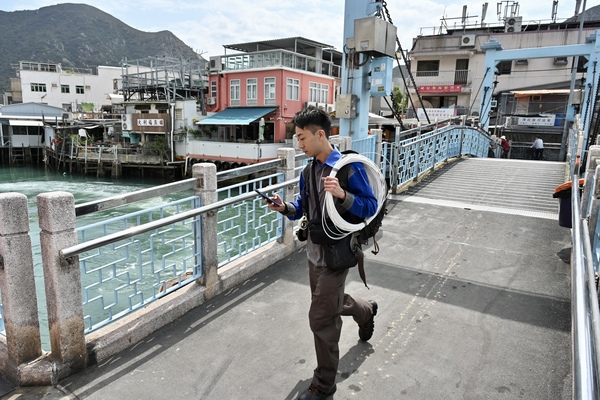Seamless Connectivity For Villages

People usually find rural life a good way to kick back and spend time at a leisurely pace. But to keep up with the pace of modern technology, the copper-based network villagers once relied on for basic telecommunications services has fallen short.
This is why the Government implemented the the Subsidy Scheme to Extend Fibre-based Networks to Villages in Remote Areas that provides telecommunications companies with financial incentives to encourage the extension of fibre-based networks to cover 235 villages in the New Territories and outlying islands. Now, more than 160 villages have already been equipped with fibre-based networks under the subsidy scheme launched by the Office of the Communications Authority.
Keeping pace
Since the middle of last year, some villages in Tai O have already been covered by such networks.
Cheung Chi-ming, a merchant in Tai O, highlights the contrast by explaining that back in the day, villagers were stuck with an Internet speed of eight megabits per second, which was shared among all users.
But now, with the fibre-based networks kicking in, they can enjoy high-speed broadband services at a speed of 1,000 megabits per second. And activities like streaming videos and browsing the Internet are seamless, free from disconnections.
The days of network disruptions hindering online transactions and the use of Octopus cards for payment are also gone. Plus, there is no longer a need to ask customers to wait patiently, he said.
Promoting e-learning
In addition to Tai O, some villages in Mui Wo are covered by the scheme, and the construction works to connect the fibre-based networks is underway.
Mui Wo School has experienced improved broadband services with faster and more stable Internet speeds, after the launch of the scheme. Teachers are now able to arrange online interactive teaching more flexibly.
Teacher Henry Wong mentioned that traditional teaching methods, relying on slides and worksheets, were often monotonous. But with such excellent broadband services, up to 30 computer tablets can connect at one time in a classroom.
Teachers can incorporate online games and interactive activities into their lessons. What is more, students are more engaged in their learning experience, creating a happy learning atmosphere.
As another example of the benefit of faster broadband services, the school has introduced a smart rope skipping machine to encourage students to exercise more and teacher Tai Tak-wah explained the benefits.
He said students’ skipping records are instantly stored in the database, which can then be compared with their classmates. It fosters a healthy sense of competition among them. It is all about having fun and staying motivated by comparing the progress with their peers.
Broadband milestone
The purpose of the scheme, initiated in 2018, is to enhance the coverage of fibre-based networks in villages in remote areas. Moreover, it provides the necessary infrastructure for other telecommunications services, such as 5G mobile and Wi-Fi services, thereby contributing to the development of Hong Kong as a smart city.
Over 160 villages have already been equipped with fibre-based networks, making broadband services available to about 80,000 residents.
Additionally, three submarine fibre cables connecting Lamma Island to Hong Kong Island, as well as connecting Cheung Chau and Peng Chau to Lantau Island respectively have also been completed.
The Office of the Communications Authority (OFCA) Head (Market & Competition) Christine Chim stated that the extension of fibre-based networks to rural areas involves large-scale engineering works, such as road excavation, laying of submarine fibre-based cables and installation of fibre optic networks.
Some of the projects even need to be constructed over country parks in remote areas without any road connections, leading to a longer implementation time.
The OFCA has been maintaining close contact with the selected fixed network operators, actively monitoring the progress of the engineering works, and also co-ordinating with other government departments to expedite the approval process, such that scheme could be completed as soon as possible.
The relevant works for all villages under the scheme are expected to be completed by 2026 with the goal of benefitting approximately 110,000 villagers in total.
Smart Training Aids Rehabilitation
Seventy-year-old Mr Lau has been experiencing difficulty walking ever since he suffered a stroke last year. After havi... Read more
Digging Deep To Overcome Obstacles
The Central Kowloon Bypass (Yau Ma Tei Section) is set to open on December 21, slashing the journey time from Yau Ma T... Read more
Adaptive System Optimises Traffic Flow
In a bustling city like Hong Kong, waiting for traffic lights to change to green is an inevitable part of life, especi... Read more
Drone Sports Add To Low-altitude Buzz
Alongside the Government’s push to develop Hong Kong’s low-altitude economy, drone sports have been gaining in pop... Read more
Construction Robots Enhance Efficiency
For the Trunk Road T2 & Cha Kwo Ling Tunnel project, the Civil Engineering & Development Department has applie... Read more
HK's Smart Development Recognised
Hong Kong has placed significant emphasis on smart transformation and development in recent years – and its efforts ... Read more

